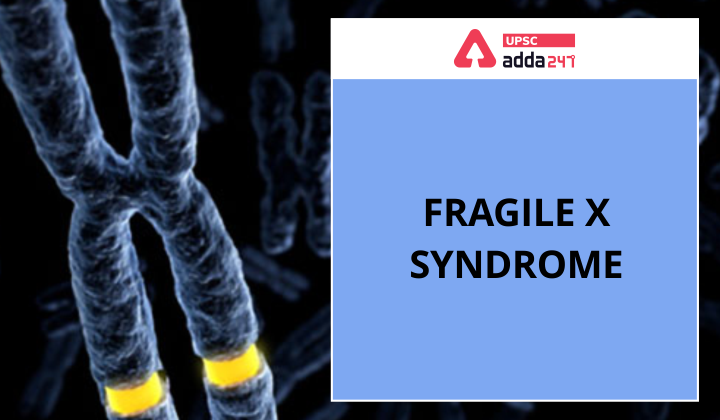Table of Contents
Fragile X Syndrome- Relevance for UPSC Exam
- GS Paper 2: Governance, Administration and Challenges- Issues relating to development and management of Social Sector/Services relating to Health.
Get free video for UPSC CSE preparation and make your dream of becoming an IAS/IPS/IRS a reality
Fragile X Syndrome- Background
- In 2017, a man in Delhi, affected by autism, underwent his first DNA blood test at the age of 40. He tested positive for Fragile X Syndrome (FXS).
- Fragile X Syndrome (FXS) is caused by changes in a gene called FMR1 which makes an important protein (FMRP). This protein is required for brain development.
Fragile X Syndrome– Key Points
- About: Fragile X syndrome is a genetic condition that causes a range of developmental problems including learning disabilities and cognitive impairment.
- Usually, males are more severely affected by this disorder than females.
- Symptoms: Affected individuals usually have delayed development of speech and language by age 2.
- Most males with fragile X syndrome have mild to moderate intellectual disability, while about one-third of affected females are intellectually disabled.
- Children with fragile X syndrome may also have anxiety and hyperactive behavior such as fidgeting or impulsive actions.
- It can also cause Attention-Deficit-Disorder (ADD) which includes an impaired ability to maintain attention and difficulty focusing on specific tasks.
- Most males and about half of females with fragile X syndrome have characteristic physical features that become more apparent with age. These features include-
- A long and narrow face, large ears, a prominent jaw and forehead, unusually flexible fingers, flat feet, and in males, enlarged testicles after puberty.
- Spread of the disease: A mother who is a carrier has a 50% chance of passing the mutated gene to her children, who will either be carriers or have FXS.
- Men who are carriers do not pass the pre-mutation to their sons, but only daughters, who become carriers.
National Centre for Disease Control (NCDC)
Autism and Fragile X Syndrome
- It was discovered and named FRAXA by three American geneticists- Ben Oostra, David Nelson, and Stephen Warren.
- They found that it was the leading inherited cause of autism worldwide.
- Prevalence of the disease: According to Centers for Disease Control and Prevention (CDC), one in 7,000 males and one in 11,000 females are affected with FXS. FXS is the leading inherited cause of autism in 4% of the population worldwide.
- The CDC estimates that one in 259 women and one in 800 men carry Fragile X.
- Prevalence in India: It is estimated there are 4,00,000 individuals who have been identified with mutated FMRI in India and 40 lakh undiagnosed carriers of the gene.
- Autism triggered by FXS is a behavioural condition: The symptoms are learning difficulty, speech delay, aggressive behaviour, hyperactivity, attention deficit, fear of the unfamiliar, sensory processing disorders, and problems in motor skills.
- These cannot be cured, but early therapy can improve the individual’s quality of life.




 TSPSC Group 1 Question Paper 2024, Downl...
TSPSC Group 1 Question Paper 2024, Downl...
 TSPSC Group 1 Answer key 2024 Out, Downl...
TSPSC Group 1 Answer key 2024 Out, Downl...
 UPSC Prelims 2024 Question Paper, Downlo...
UPSC Prelims 2024 Question Paper, Downlo...





